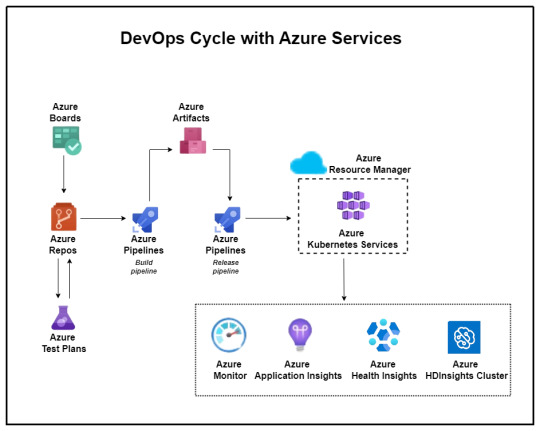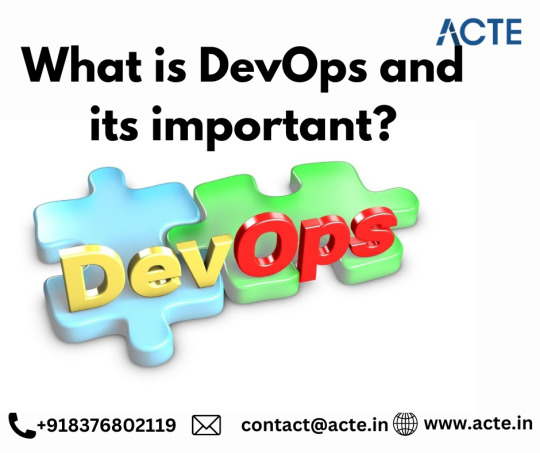#Infrastructure as code
Text
In cloud computing, the demand for speed, scalability, and reliability significantly influences IT infrastructure development strategies. As cloud ecosystems grow more complex and integral to operations, the potential security risks and points of failure increase. One pivotal innovation that aligns with these needs is Infrastructure as Code (IaC).
0 notes
Text
Driving Innovation: A Case Study on DevOps Implementation in BFSI Domain
Banking, Financial Services, and Insurance (BFSI), technology plays a pivotal role in driving innovation, efficiency, and customer satisfaction. However, for one BFSI company, the journey toward digital excellence was fraught with challenges in its software development and maintenance processes. With a diverse portfolio of applications and a significant portion outsourced to external vendors, the company grappled with inefficiencies that threatened its operational agility and competitiveness. Identified within this portfolio were 15 core applications deemed critical to the company’s operations, highlighting the urgency for transformative action.

Aspirations for the Future:
Looking ahead, the company envisioned a future state characterized by the establishment of a matured DevSecOps environment. This encompassed several key objectives:
Near-zero Touch Pipeline: Automating product development processes for infrastructure provisioning, application builds, deployments, and configuration changes.
Matured Source-code Management: Implementing robust source-code management processes, complete with review gates, to uphold quality standards.
Defined and Repeatable Release Process: Instituting a standardized release process fortified with quality and security gates to minimize deployment failures and bug leakage.
Modernization: Embracing the latest technological advancements to drive innovation and efficiency.
Common Processes Among Vendors: Establishing standardized processes to enhance understanding and control over the software development lifecycle (SDLC) across different vendors.
Challenges Along the Way:
The path to realizing this vision was beset with challenges, including:
Lack of Source Code Management
Absence of Documentation
Lack of Common Processes
Missing CI/CD and Automated Testing
No Branching and Merging Strategy
Inconsistent Sprint Execution
These challenges collectively hindered the company’s ability to achieve optimal software development, maintenance, and deployment processes. They underscored the critical need for foundational practices such as source code management, documentation, and standardized processes to be addressed comprehensively.
Proposed Solutions:
To overcome these obstacles and pave the way for transformation, the company proposed a phased implementation approach:
Stage 1: Implement Basic DevOps: Commencing with the implementation of fundamental DevOps practices, including source code management and CI/CD processes, for a select group of applications.
Stage 2: Modernization: Progressing towards a more advanced stage involving microservices architecture, test automation, security enhancements, and comprehensive monitoring.
To Expand Your Awareness: https://devopsenabler.com/contact-us
Injecting Security into the SDLC:
Recognizing the paramount importance of security, dedicated measures were introduced to fortify the software development lifecycle. These encompassed:
Security by Design
Secure Coding Practices
Static and Dynamic Application Security Testing (SAST/DAST)
Software Component Analysis
Security Operations
Realizing the Outcomes:
The proposed solution yielded promising outcomes aligned closely with the company’s future aspirations. Leveraging Microsoft Azure’s DevOps capabilities, the company witnessed:
Establishment of common processes and enhanced visibility across different vendors.
Implementation of Azure DevOps for organized version control, sprint planning, and streamlined workflows.
Automation of builds, deployments, and infrastructure provisioning through Azure Pipelines and Automation.
Improved code quality, security, and release management processes.
Transition to microservices architecture and comprehensive monitoring using Azure services.
The BFSI company embarked on a transformative journey towards establishing a matured DevSecOps environment. This journey, marked by challenges and triumphs, underscores the critical importance of innovation and adaptability in today’s rapidly evolving technological landscape. As the company continues to evolve and innovate, the adoption of DevSecOps principles will serve as a cornerstone in driving efficiency, security, and ultimately, the delivery of superior customer experiences in the dynamic realm of BFSI.
Contact Information:
Phone: 080-28473200 / +91 8880 38 18 58
Email: [email protected]
Address: DevOps Enabler & Co, 2nd Floor, F86 Building, ITI Limited, Doorvaninagar, Bangalore 560016.
#BFSI#DevSecOps#software development#maintenance#technology stack#source code management#CI/CD#automated testing#DevOps#microservices#security#Azure DevOps#infrastructure as code#ARM templates#code quality#release management#Kubernetes#testing automation#monitoring#security incident response#project management#agile methodology#software engineering
0 notes
Text
Installing GitLab, Runner, and Container Registry on Your Home Server
Everything You Need to Install GitLab, Runner, and Container Registry @gitlab #gitlab #devops #cicd #continuousintegration #continuousdeployment #iac #containers #homelab #homeserver #virtualization #vhtforums #selfhosted #selfhosting #nginxproxymanager
So, I wanted to create a concise guide to help you guys get up and running with GitLab, the GitLab Runner, and GitLab Registry. I spent quite a bit of time working on this in my home lab and hammering out the details so you don’t have to! Let’s look at everything you need to install GitLab, GitLab runner, and GitLab container registry.
Table of contentsWhy GitLab?My setupPrerequisites and…

View On WordPress
0 notes
Text

MACH Architecture and Cloud Infrastructure: A Powerful Combination for a New Programme with PII Requirements
The Challenge: was to design and implement an appropriate infrastructure for a new programme with ambiguous specifications and no knowledge of the potential audience. This program aimed to support various global markets with different needs and preferences.
In software delivery, working on a greenfield project is a rare and challenging opportunity. It is exciting because we can design the system ground up without being constrained by the legacy and using business requirements to shape the system. However, it is also daunting because the scale and the boundaries of the project are unclear.
One of the most complex requirements were around PII (Personally Identifiable Information). The rules and the regulations for PII vary significantly among countries, which creates additional complexity and overhead in terms of business rules, implementation and infrastructure.
In addition to the challenges with requirements, being an Agile program, we anticipate many changes and adjustments as the product is used by the consumer. We will iterate and respond to the consumer feedback promptly.
The Solution: was to build a cloud-based application following MACH architecture. MACH is a modern approach to software development that stands for Microservices, API-first, Cloud-native, and Headless.
Cloud infrastructure allowed us to scale up and down easily as needed. This flexibility was crucial, as we had no data on the required infrastructure for the project. Therefore, we started with minimal resources and let the system scale and evolve based on the data we collected. Moreover, we avoided the infrastructure cost when it was not necessary, and only paid for what we used.
Thanks to cloud’s flexibility we could scale in isolation for each region if needed, making the system adaptable for each market. This feature was very beneficial within the context of PII, as we could create fully isolated regions within the same project.
We chose AWS as our primary cloud provider and some parts of the system used Azure because of the business requirements. Fortunately with today’s technology, different cloud providers can work together within the same project.
Akamai, which is a Content Delivery Network (CDN), created our ecosystem with strong security features. Security was very vital, as global reach came with global risks. Akamai’s AI powered and machine learning models protected our system from malicious bot detection to various attack vectors.
Being a small development team, we utilised automation where we could. Using infrastructure as code (IaC), we developed one-click environment creation from scratch, so that the product could be deployed anywhere AWS operates. This feature was especially useful in the context of PII, to comply with local regulations.
For one-click environment creations, we used Terraform with well-defined and documented roles and permissions. Terraform is a tool that allows teams to define and manage infrastructure as code. Terraform also helped us to track changes, and enabled collaboration within the team. As infrastructure was codified we avoided all the ambiguities of manual changes of the settings and configurations which helped us to troubleshoot quickly and efficiently when needed.
Following MACH architecture and utilising the latest cloud technology made this project possible with its small budget, tough timeline and limited resources.
#MACH#aws#cloud#infrastructure as code#leadership#Azure#international#azure#cloud computing#cloud infrastructure
0 notes
Text
Don't Just Sit There! Start DevOps and Its Important
In the rapidly evolving landscape of software development, the term "DevOps" has become a buzzword. But what exactly is DevOps, and why is it gaining such widespread recognition and adoption? In this blog post, we'll unravel the concept of DevOps, exploring its core principles and delving into the reasons why it has become indispensable for modern businesses.
Unlocking the code of success through DevOps training in Bangalore – where collaboration meets innovation, shaping a digital masterpiece. 🚀💻 #DevOpsExcellence #InnovateWithCollaboration #TechRevolution

Understanding DevOps:
DevOps is a culture, a set of practices, and an approach that aims to bridge the gap between software development (Dev) and IT operations (Ops). It emphasizes collaboration, communication, and integration between these traditionally siloed teams throughout the entire software development lifecycle. The primary goal of DevOps is to enable organizations to deliver high-quality software at a faster pace, ensuring continuous integration, delivery, and deployment.
Why DevOps Matters:
Increased Efficiency: DevOps streamlines the development process, reducing manual intervention and accelerating the release cycle. This results in quicker delivery of features and updates, ultimately enhancing time-to-market.
Higher Quality Software: Continuous integration and automated testing in a DevOps environment contribute to the production of higher-quality software. Early detection of issues allows for timely resolutions, minimizing the presence of bugs and vulnerabilities.
Enhanced Collaboration: DevOps breaks down traditional barriers between teams, fostering a culture of shared responsibility. This collaborative environment leads to improved communication, understanding, and a more cohesive workflow.
Adaptability to Change: In today's dynamic business landscape, the ability to adapt quickly is paramount. DevOps enables organizations to respond rapidly to changing market demands, ensuring they stay competitive and innovative.

5. Startups and Scale-Ups
Agile Growth: DevOps is particularly beneficial for startups and scale-ups experiencing rapid growth. It ensures that the pace of development aligns with the increasing demands of a growing user base.
Cost-Efficiency: Startups often operate on tight budgets. DevOps helps optimize resources, reduce downtime, and achieve cost efficiency.
6. Enterprise Transformation
Cultural Shift: For large enterprises, adopting DevOps often involves a cultural shift. It encourages collaboration and transparency, breaking down traditional hierarchical barriers.
Risk Mitigation: DevOps practices contribute to risk mitigation by identifying and addressing issues early in the development process, reducing the likelihood of costly errors in production.Dive into the world of possibilities with DevOps online courses – sculpting your tech future, one virtual lesson at a time. 💻🌐 #TechSculptor #DevOpsSkills #VirtualClassroom"
7. Scalability:
As organizations grow, scalability becomes a crucial factor. DevOps practices enable seamless scalability by providing the tools and processes needed to handle increased workloads without sacrificing efficiency or compromising system stability.
DevOps is not just a set of tools; it's a cultural shift that empowers organizations to thrive in the fast-paced world of technology. By promoting collaboration, automation, and continuous improvement, DevOps has emerged as a fundamental approach for businesses seeking to remain agile, efficient, and customer-focused in the digital age. Embracing DevOps isn't just about adopting new practices; it's about cultivating a mindset that values collaboration, innovation, and excellence in every line of code.
#DevOps engineer#DevOps principles#Automation in DevOps#Cloud technologies#Monitoring tools#Infrastructure as Code#DevOps roadmap#IT career#DevOps success.
0 notes
Video
youtube
Terraform Tutorial & Project Setup | Create AWS EC2 Instance Using Terra... Full Video Link - https://youtu.be/Vf6g1EB3ukQ Check out this new video on the CodeOneDigest YouTube channel! Learn terraform tool and infrastructure as code with example. Learn how to create aws resources using terraform scripts. #video #terraform #iac #infrastructureascode #aws #codeonedigest@java @awscloud @AWSCloudIndia @YouTube @codeonedigest #aws #terraform #iac #infrastructureascode #aws #terraform #devops #awscloud #awstraining #awstutorial #terraformtutorial #terraformtutorialforbeginners #terraformdevopstutorial #terraformprojectaws #terraformprojectstructure #terraformprojectsforbeginners #terraformfundamentals #terraformscriptforec2instance #terraformscripttocreateec2instance #terraformscripttutorial #createec2instanceusingterraform #createec2instanceinaws #terraformvariablestutorial #terraformvariables #tfvstfvars
1 note
·
View note
Text
Release Management: Best Practices for Seamless Deployments
Unlock the secrets of seamless software releases with our in-depth guide on release management best practices - from version control to CI/CD, ensuring success in every deployment. #ReleaseManagement #SoftwareDeployment #CI_CD #AgileDevelopment
In the fast-paced and ever-evolving world of software development, embracing the power of efficient release management becomes paramount. It is the key that unlocks the doors to delivering exceptional, high-quality products on schedule, leaving a lasting impression on users. Release management encompasses a profound orchestration, entailing meticulous planning, seamless coordination, and diligent…

View On WordPress
#agile methodologies#agile practices#Ansible#automated testing#best practices#CI/CD#communication and collaboration#continuous deployment#continuous integration#deployment strategy#DevOps#documentation#environment management#feedback loop#Git#IaC#Infrastructure as code#monitoring metrics#post-release evaluation#Release management#rollback plan#software deployment#software development#software engineering#Terraform#version control
1 note
·
View note
Text
Exciting Mock interview with DevOps/AWS engineer #devops #cloud #aws #devopsengineer #cloudengineer
Interviewer: Welcome to this exciting mock interview for the role of a DevOps/AWS Engineer! Today, we have an enthusiastic candidate eager to showcase their skills. Let’s begin!
Candidate: Thank you! I’m thrilled to be here.
Interviewer: Great to have you. Let’s start with a classic question: What attracted you to the field of DevOps and working with AWS?
Candidate: DevOps combines my passion…

View On WordPress
#Automation#AWS#CI/CD#cloud engineering#cloud technology#collaboration#communication#continuous integration#cost optimization#cross-functional teams#DevOps#disaster recovery#high availability#IaC#incident management#infrastructure as code#mock interview#performance optimization#scalability#security#tech trends
0 notes
Link
Report determine, segment, and forecast the global infrastructure as code market based on component, type, infrastructure type, deployment mode, organization size, vertical, and region in terms of value
#marketsandmarkets research pvt. ltd.#infrastructure as code market#infrastructure as code#iac market#iac market size
0 notes
Link

IaC helps companies of all sizes and types to manage their cloud infrastructure and IT, abide by governing rules, increase efficiency and reduce financial misuse. After knowing the benefits of IaC for your business, make sure you incorporate it into your infrastructure to help your business attain success in a digital era.
1 note
·
View note
Text
Infrastructure is one of the essential principles of software development. It is the critical factor that ensures stability in an application’s performance. Infrastructure can refer to servers, firewalls, load balancers, databases, container clusters, etc.
Infrastructure as Code (IaC) is the practice of managing, provisioning, and configuring infrastructure by using a defined code in a descriptive cloud-operating model. It completely circumvents the manual approach to managing a company’s infrastructure. IaC allows users to review, modify, test, maintain, and reuse their infrastructure without depending on the IT team.
0 notes
Text
Terragrunt vs Terraform: Battle of DevOps tools
Terragrunt vs Terraform: Battle of DevOps tools @vexpert #homelab #terraform #terragrunt #infrastructureascode #cloudinfrastructuremanagement #devops #terragruntconfiguration #dependencymanagement #remotestatemanagement
Infrastructure as Code (IaC) has become widely adopted by many, including in production environments, developers, and home lab enthusiasts to deploy infrastructure. Terraform is arguably one of the top tools used by DevOps professionals. However, there is another tool you may not have heard about called Terragrunt. What is Terragrunt? What about Terragrunt vs Terraform? Are they competing…

View On WordPress
#Cloud Infrastructure Management#dependency management#infrastructure as code#managing multiple environments#remote state management#reusable terraform components#terraform#terraform modules#terragrunt#terragrunt configuration
0 notes
Text


baby hannie
for @hongjoongpresent
#i remember watching this skz code at my mom's house and her being extremely confused#stray kids#createskz#han jisung#hyunjin#3rachasource#forhanji#bystay#userbeepls#usertsu#leenope#userjinnie#userlau#usersun#usersa#userlluna#usermask#okay back to writing my paper on fucking internet infrastructure#a topic i picked for myself for some reason#mine
457 notes
·
View notes